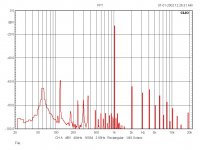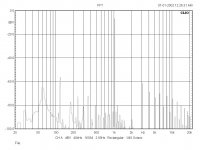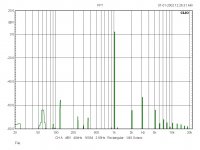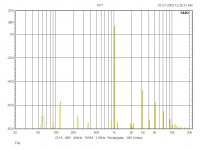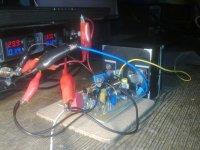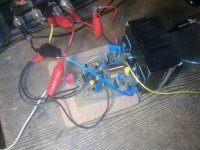Algar. You said 0.01% THD which looks about right. Do you have the spectrum?
1 mA is very bright with most LED's. Even 47K @ 42V might be more than you want. Use lets say 2 x 22K so as to protect things ( one each side ) . If something bad happens it just will be brighter.
1 mA is very bright with most LED's. Even 47K @ 42V might be more than you want. Use lets say 2 x 22K so as to protect things ( one each side ) . If something bad happens it just will be brighter.
1 kHz and 10 kHz if the test will allow. 0.3 V. 1V . 2.83 V and 5 V rms always good to see. 5 x 5 /4 = is about 6 watts or 3 watts 8R. Easy enough to test and won't get a 11 watt resistor into trouble. Don't do what I did with a Hypex module. I had the 10:1 probbe swithed on thinking it was 1 watt. It was more like 100 watts ( 28 V rms). Hypex are modest about the spec. The resistors although in the right range were smoking. The Hypex although on a thin ( 2.3 mm like a Naim Nait ) chassis was barely warm ! It wasn't a test of a few seconds, more like an hour! The load will take 100 watts.
2 x 7K5 for the LED?
You can put the LED between +/-. 2 x 15 K if so. This will tell you when the PSU is discharged. You can put a revered biased diode across the LED to protect it should you make a mistake or a weird event takes place. This is also a way of doing it across an AC supply. Most LED's are only good for about 5V reversed biased. Sometimes although they seem to work for a week or so if given too much they will often fail soon after. If you get the diode the wrong way around no harm done except the LED won't light. 1N4007 is perfect.
2 x 7K5 for the LED?
You can put the LED between +/-. 2 x 15 K if so. This will tell you when the PSU is discharged. You can put a revered biased diode across the LED to protect it should you make a mistake or a weird event takes place. This is also a way of doing it across an AC supply. Most LED's are only good for about 5V reversed biased. Sometimes although they seem to work for a week or so if given too much they will often fail soon after. If you get the diode the wrong way around no harm done except the LED won't light. 1N4007 is perfect.
Hi. As requested spectrum at from left to right, 0.3 V, 1V, 2.83 V and 5 Vrms, in 8 ohms with my CLIO system. At 1V, with CLIO I measured 0.16% THD, but my CLIO always measure higher that the Keithley 2215-P Audio Analyser. The source in the Keithley is much purer and there is no computer pollution, probably much lower supply forethought.
Attachments
For a whole day original naim design has been playing, laboratory +/- 30V. MONO(one channel).
It is very stable with TIP42/41's as drivers, 2sc5200 outputs, VAS stage 2N5401 and 5551, bias sense transistor 5551, VI limiter transistors MPSA06 and 56.
CSS and LPT diff. BC182B and 2xBC550C(matched) accordingly.
Miller is 56pF, everything else is as in Original Design except outputs inductor ~ 0.5uH 15R parallel. Forgot, i had no 620R resistor... so 560R is placed on CSS emitter.
It sounds dam good... even on laboratory supply (unusual long PSU wires).
(unusual long PSU wires).
All capacitors are tantalum except input(tant is good too here) and COG TYPE
I decoupled 2SC5200 outputs with small electrolytic (10uf) and 47nF ceramic/MKP for better EMI protection...thats all what is needed.....
Why ppl even bother to modify naim amplifiers ??? I don't even use LPT and VAS stage separate PSU's... still, the sound, especially rhythm(timing) sooooo nice. !!!!
I don't even use LPT and VAS stage separate PSU's... still, the sound, especially rhythm(timing) sooooo nice. !!!!
Soon Ebay H-140 china kits will be replaced by clone originals, lets hope they won't fight each-other with 1 shared filter-bank PSU.
It is very stable with TIP42/41's as drivers, 2sc5200 outputs, VAS stage 2N5401 and 5551, bias sense transistor 5551, VI limiter transistors MPSA06 and 56.
CSS and LPT diff. BC182B and 2xBC550C(matched) accordingly.
Miller is 56pF, everything else is as in Original Design except outputs inductor ~ 0.5uH 15R parallel. Forgot, i had no 620R resistor... so 560R is placed on CSS emitter.
It sounds dam good... even on laboratory supply
All capacitors are tantalum except input(tant is good too here) and COG TYPE
I decoupled 2SC5200 outputs with small electrolytic (10uf) and 47nF ceramic/MKP for better EMI protection...thats all what is needed.....
Why ppl even bother to modify naim amplifiers ???
Soon Ebay H-140 china kits will be replaced by clone originals, lets hope they won't fight each-other with 1 shared filter-bank PSU.
Attachments
Well, you did start out with several modifications like that yourself. Why did you decide that mods would improve the design? I think that like everyone else, without experience, we assume mods and refinements will improve something that is cheap and simple enough for anyone to mess with. So we mess about by imagination, guesswork and by ear and some guys will get close to good Naim sound but many will lose the sound quality and the plot......Why ppl even bother to modify naim amplifiers ???I don't even use LPT and VAS stage separate PSU's... still, the sound, especially rhythm(timing) sooooo nice...
It's great that you have succeeded and others can see how you did it - even with a very low cost kit and a few changes. The larger compensation cap of 56 pF is an obvious requirement if using low Cob (small signal) transistors instead of ZTX653/753. If your rail voltage is anything like +/- 40V, I'll bet they run hot though!
If your rail voltage is anything like +/- 40V, I'll bet they run hot though!
Yep, got me thinking too, will have to work on specific heat sink for TO92.
It was one of a road for sure
PSU is still a problem... is there someone using stereo with one PSU ?
Problem is that i got 4 transformers, don't even know what they are(each are ~300W), fully covered with EPOX... i did measure the secondaries and i was able to connect TWO of them together to produce +/- 35V AC(dual with centertap gnd)
So there is a chance for DUAL mono configuration, its time consuming, but interesting
Easiest and preferred is to use allready made h-140 amp case, PSU and protection... and leave those transformers for something bigger.
The original NAP140 and all the early series amps just use a single PSU and the 140 in particular sounds possibly the best of them, whatever the improvements since then. Some are bridge-mode with regulated supplies but most are as simple as can be. Just look at all the Naim internal pics on the web. The refinement of fully separate supplies and grounding for each channel (called dual-mono construction) is widely used in high end amplifiers and pretenders but Naim sound was not built on it.
The NAP200 design you see here recently, is almost dual mono, having a special dual winding transformer and separate rectifiers, but it's another product with a newer design approach. Using the single core but the same same VA rating, there will still be a power sharing affect of one channel on the other. The main difference with this later design is the very careful grounding layout of the PCB which should make a whole better amplifier possible. The NAP140 and most earlier models were all grounded rather poorly with lots of parallel wiring runs which didn't pay much attention to low noise guidelines - more likely it was just for the ordered looks of mil. standard wiring looms.
I doubt if the transformer and dual PSUs alone will be a large benefit, given the diffused imaging of NAP designs generally. The meticulous grounding layout and integration with the preamp wiring is where I look forward to hearing some worthwhile improvement (when and if I can get my parts together ) Even so, I won't be scrapping my NAP140 original and clones any time after that
) Even so, I won't be scrapping my NAP140 original and clones any time after that 
The NAP200 design you see here recently, is almost dual mono, having a special dual winding transformer and separate rectifiers, but it's another product with a newer design approach. Using the single core but the same same VA rating, there will still be a power sharing affect of one channel on the other. The main difference with this later design is the very careful grounding layout of the PCB which should make a whole better amplifier possible. The NAP140 and most earlier models were all grounded rather poorly with lots of parallel wiring runs which didn't pay much attention to low noise guidelines - more likely it was just for the ordered looks of mil. standard wiring looms.
I doubt if the transformer and dual PSUs alone will be a large benefit, given the diffused imaging of NAP designs generally. The meticulous grounding layout and integration with the preamp wiring is where I look forward to hearing some worthwhile improvement (when and if I can get my parts together
I suggest using a standard 25 + 25VAC transformer (almost right for a NAP140) giving 35VDC rails. 200-250VA rating is fine as the original was around 240. Read comments by Martin Clark at Mod. 7 here: Modifying Naim Audio power amplifiers A pair of standard 160VA transformers at 25+25VAC should be fine for a dual mono build.
The 40V rails shown on the generic NAP schematic are actually suit NAP250, a bridged amplifier with regulated supplies or perhaps NAP180. It will require adjusting bias currents in the input and VAS stages when you use reduced rail voltages, but that's not difficult if you lower the current source emitter resistors proportionally. Unfortunately, 35VAC rectified gives around 51VDC. That's too high for the topology and would mean a lot of redesigning with higher rated parts. I wouldn't go there unless you need more power or just want to experiment. I think that another design/kit would be the preferred way to use that transformer, as you suggest.
The 40V rails shown on the generic NAP schematic are actually suit NAP250, a bridged amplifier with regulated supplies or perhaps NAP180. It will require adjusting bias currents in the input and VAS stages when you use reduced rail voltages, but that's not difficult if you lower the current source emitter resistors proportionally. Unfortunately, 35VAC rectified gives around 51VDC. That's too high for the topology and would mean a lot of redesigning with higher rated parts. I wouldn't go there unless you need more power or just want to experiment. I think that another design/kit would be the preferred way to use that transformer, as you suggest.
Last edited:
The Hum looks terrible @ -55dB relative to signal. The Buzz components add up to much worse.Hi. As requested spectrum at from left to right, 0.3 V, 1V, 2.83 V and 5 Vrms, in 8 ohms with my CLIO system. At 1V, with CLIO I measured 0.16% THD, but my CLIO always measure higher that the Keithley 2215-P Audio Analyser. The source in the Keithley is much purer and there is no computer pollution, probably much lower supply forethought.
I have not tested any of my amplifiers by your method, so I cannot make a comparison.
What does Hum + Noise measure when the input is shorted?
Last edited:
Hum aside the results are very interesting. Might be good to see one of the test oscillator. Very big thanks. If the TR4 emitter was fitted with 5R6 it would be interesting to rerun the 1V test. The NAP 250 I saw measured had more 2 nd harmonic ( 2 kHz ) than 3 rd ( 3 kHz ) by a small margin.
Something very weird has just happened in my world of work. My boss would not like me to say too much so I will just say the basics. The results so dramatic I would have thought it impossible.
I have a problem where two frequenicies beat. I have it under control as far as the spectrum analyser is concerned. The wave exactly hugs the scope upper horizontal line. This means I can still see the beat even though below -70 dB. I cured the problem by doing exactly what Naim did. I have the dangerous bits in one box and this is anchored to mains Earth. The sub unit ( like NAC62 ) floats and is isolated by rubber feat. The results are now excellent. To test if I wasn't deluding myself I touched the sub unit with the soldering iron ( an earth ). Suddenly is was dreadful, it is more than a hum loop. Well done Naim for giving me the idea. We don't have a vast budget for this project so it's good to get a bit of luck. I was going to investigate the DC PSU. My hunch is it wouldn't have changed much. Music does this just as much. The sub box is earthed at RF. I have 100 R and 100 nF in paralell between big box chassis and the floating 0V. All very standard stuff with big advantages here. Maybe this amp needs the same ?
Something very weird has just happened in my world of work. My boss would not like me to say too much so I will just say the basics. The results so dramatic I would have thought it impossible.
I have a problem where two frequenicies beat. I have it under control as far as the spectrum analyser is concerned. The wave exactly hugs the scope upper horizontal line. This means I can still see the beat even though below -70 dB. I cured the problem by doing exactly what Naim did. I have the dangerous bits in one box and this is anchored to mains Earth. The sub unit ( like NAC62 ) floats and is isolated by rubber feat. The results are now excellent. To test if I wasn't deluding myself I touched the sub unit with the soldering iron ( an earth ). Suddenly is was dreadful, it is more than a hum loop. Well done Naim for giving me the idea. We don't have a vast budget for this project so it's good to get a bit of luck. I was going to investigate the DC PSU. My hunch is it wouldn't have changed much. Music does this just as much. The sub box is earthed at RF. I have 100 R and 100 nF in paralell between big box chassis and the floating 0V. All very standard stuff with big advantages here. Maybe this amp needs the same ?
The big hum on the spectrum is because of the CLIO box. If I used a real test equipment, not a card into a PCB I get much better result. It is possibly ground related. No there was no 5R6 resistor installed.
There is no hum on the amp output. Measured with a voltmeter, in the mv range with no signal.
We can also see that the CLIO measured much higher THD than my Keithley Audio analyzer (a real test equipment, very low noise voltmeter to start with). The higher THD is probably caused by the large hum and other power supply spectra spikes...
And Nigel, my amp is not mounted in a box yet, just on a test bed. Then I cannot comment on the grounding issue just yet
There is no hum on the amp output. Measured with a voltmeter, in the mv range with no signal.
We can also see that the CLIO measured much higher THD than my Keithley Audio analyzer (a real test equipment, very low noise voltmeter to start with). The higher THD is probably caused by the large hum and other power supply spectra spikes...
And Nigel, my amp is not mounted in a box yet, just on a test bed. Then I cannot comment on the grounding issue just yet
Last edited:
What does Hum + Noise measure when the input is shorted?
are you confirming that Hum+Noise on the output when input is shorted is 0.0mVac?................
There is no hum on the amp output. .............
What if you connect an interconnect and short the far end?
What if you connect two interconnects of the stereo amplifier and short the far end barrels together?
I regularly measure 0.0mVac using a variety of DMM set to 199.9mVac scale when the input is shorted to signal return.Noise. With inputs shorted to gnd, I measured 2.5mVac rms at the output, without a chassis and flying wires. It may be better in a proper enclosure.
If there is a problem I can see 0.1mVac to 0.3mVac.
That 0.0mVac is not zero. The average reading DMM are reporting an average that is less than ½LSB (least significant bit) and means <0.05mVac average.
This is with the amplifier and PSU lying open on the bench with a fluorescent lamp and LED lamp and soldering station on, creating a lot of noise.
2.5mVac is 50times (+34dB) noisier than 0.05mVac.
That is what your FFT is reporting.
The Hum+Buzz+Noise is abominable.
You have to find and eliminate the error in your wiring.
Your FFT will hopefully show the 60Hz and harmonics upto 500Hz, all @ levels 30dB below what you have shown in post2204.
Last edited:
We seem to be doing best mods right now. For a long time the quality of the kits was the question. Right now we are trying to get the kits to be more like the real Naim amplifiers.
The modification of greater interest is the TR4 PNP VAS transistor. What it is,how it is driven. VAS is the name somewhat carelessly given to what is mostly a current to voltage converter. We are looking to pull the distortion spectrum back to a true Naim type where 2nd harmonic is equal or above the 3rd. At the moment we have a standard amplifier type. The reason seems to be the Vbe of TR4 sits too low. What some might not understand is in analogy you asked for chocolate and were given coffee. Neither is plain milk and can be very good. All the same, the real Naim has a destinct flavour.
I was told long before tuning an engine get it to work correctly, this was and is called Blue-printing. Often the tuning is not required when the design is correct. Also a tuned incorrect thing usually has no value at all and is unreliable.
On this hum problem I suspect a simple star earth will solve it. Star earth's are sometimes far from easy to arrive at.
The modification of greater interest is the TR4 PNP VAS transistor. What it is,how it is driven. VAS is the name somewhat carelessly given to what is mostly a current to voltage converter. We are looking to pull the distortion spectrum back to a true Naim type where 2nd harmonic is equal or above the 3rd. At the moment we have a standard amplifier type. The reason seems to be the Vbe of TR4 sits too low. What some might not understand is in analogy you asked for chocolate and were given coffee. Neither is plain milk and can be very good. All the same, the real Naim has a destinct flavour.
I was told long before tuning an engine get it to work correctly, this was and is called Blue-printing. Often the tuning is not required when the design is correct. Also a tuned incorrect thing usually has no value at all and is unreliable.
On this hum problem I suspect a simple star earth will solve it. Star earth's are sometimes far from easy to arrive at.
And how do we improve TR4 situation
I'd be interested in the answer to this too, especially as this appears to be an almost entirely accurate NAP200 clone in terms of PCB layout and component values.
Chris
- Home
- Amplifiers
- Solid State
- NAP-140 Clone Amp Kit on eBay
